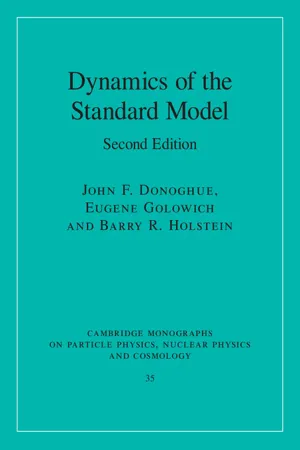
- English
- PDF
- Available on iOS & Android
Dynamics of the Standard Model
About this book
Describing the fundamental theory of particle physics and its applications, this book provides a detailed account of the Standard Model, focusing on techniques that can produce information about real observed phenomena. The book begins with a pedagogic account of the Standard Model, introducing essential techniques such as effective field theory and path integral methods. It then focuses on the use of the Standard Model in the calculation of physical properties of particles. Rigorous methods are emphasized, but other useful models are also described. This second edition has been updated to include recent theoretical and experimental advances, such as the discovery of the Higgs boson. A new chapter is devoted to the theoretical and experimental understanding of neutrinos, and major advances in CP violation and electroweak physics have been given a modern treatment. This book is valuable to graduate students and researchers in particle physics, nuclear physics and related fields.
Frequently asked questions
- Essential is ideal for learners and professionals who enjoy exploring a wide range of subjects. Access the Essential Library with 800,000+ trusted titles and best-sellers across business, personal growth, and the humanities. Includes unlimited reading time and Standard Read Aloud voice.
- Complete: Perfect for advanced learners and researchers needing full, unrestricted access. Unlock 1.4M+ books across hundreds of subjects, including academic and specialized titles. The Complete Plan also includes advanced features like Premium Read Aloud and Research Assistant.
Please note we cannot support devices running on iOS 13 and Android 7 or earlier. Learn more about using the app.
Information
Table of contents
- Cover
- Half Title
- Series Page
- Title Page
- Imprints
- Dedication
- Contents
- Preface to the second edition
- I Inputs to the Standard Model
- II Interactions of the Standard Model
- III Symmetries and anomalies
- IV Introduction to effective field theory
- V Charged leptons
- VI Neutrinos
- VII Effective field theory for low-energy QCD
- VIII Weak interactions of kaons
- IX Mass mixing and CP violation
- X The N[sub(c)][sup(-1}] expansion
- XI Phenomenological models
- XII Baryon properties
- XIII Hadron spectroscopy
- XIV Weak interactions of heavy quarks
- XV The Higgs boson
- XVI The electroweak sector
- Appendix A Functional integration
- Appendix B Advanced field-theoretic methods
- Appendix C Useful formulae
- References
- Index